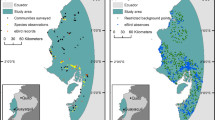Abstract
Species mapping is a useful conservation tool for predicting patterns of biological diversity, or identifying geographical areas of conservation significance. Mapping can also improve our understanding of the appropriateness of habitat areas for individual species. We outline a computer-based methodology, PREDICT, for the analysis of the habitat requirements of species in a combined GIS-statistical programming environment. The paper details the statistical background to the approach adopted, the program structure and input file information and then applies these techniques to bird data from Bioko Island, West Africa. It produces images and statistics that assess the potential of unstudied areas for wildlife for which presence/absence data and basic habitat information are available. Suitability for target species is determined within surveyed and non-surveyed squares by a form of weights of evidence. The program measures the degree of association between habitat factors and presence/absence of target species by means of χ2 tests. The overall suitability weighting of each square, as the sum of all individual habitat factor weightings, is finally displayed in maps depicting areas of highly suitable, suitable, unsuitable and highly unsuitable habitat. Statistical relations between vegetation, rainfall and landscape features on Bioko Island and the location of 9 endemic bird taxa are presented herein. Final confirmation of the accuracy of predictions of the studied bird taxa will ensue from future field observations. However, in a series of misclassification tests of the program, actual distribution detection rate was in excess of 90%. The use of PREDICT can guide investigations of little known species in remote areas and provide a practical solution to identify areas of high rare species diversity in need of conservation.
Similar content being viewed by others
References
Akçcakaya HR (1996) RAMASşR Metapop: Viability Analysis for Stage-Structured Metapopulations (Version 2.0). Applied Biomathematics, Setauket, New York
Bailey RG and Hogg HC (1986) A world ecoregions map for resource reporting. Environmental Conservation 13: 195–203
Bonham-Carter GF (1994) Geographic Information Systems for Geoscientists. Pergamon Press, Oxford
Butterfield BR, Csuti B and Scott JM (1994) Modelling vertebrate distributions for gap analysis. In: Miller RI (ed) Mapping the Diversity of Nature, pp 53–68. Chapman & Hall, London
Fa JE (1992) Conservaciön de los Ecosistemas Forestales en Guinea Ecuatorial. IUCN, Gland and Cambridge
Fa JE and Morales LM (1993) Patterns of mammalian diversity in Mexico. In: Ramamoorthy TP, Bye R, Lot A and Fa JE (eds) The Biological Diversity of Mexico, pp 319–364. Oxford University Press, New York and Oxford
FED/DHV (1990) Proyecto de Rehabilitaciön de Cacao. Isla De Bioco. Uso Actual y Potential de las Tierras. Repùblica de Guinea Ecuatorial. Ministerio de Agricultura, Ganadería, Pesca y Forestal. Unpublished document, Malabo
Fish and Wildlife Service (1981) Standards for the Development of Suitability Index Models. Ecological Services Manual 103. US Department of the Interior, Fish and Wildlife Service, Division of Ecological Services. Government Printing Office, Washington, DC
IGN (1979) Repùblica de Guinea Ecuatorial: Provincia de Bioco. Mapa Topogràfico Escala 1: 100.000. Instituto Geogràfico Nacional de España, Madrid
Juste J (1992) Zonaciön Ecolögica y Evaluaciön del Impacto Ambiental de los Usos Actuales de la Ísla de Bioco. Proyecto UTF/EQG/002/EQG, FAO, Malabo
Juste J and Fa JE (1994) Biodiversity conservation in the Gulf of Guinea islands: taking stock and preparing action. Biodiversity and Conservation 3: 759–771
Lancia R, Adams DA and Lunk EM (1986) Temporal and spatial aspects of species-habitat models. In: Verner J, Morrison ML and John Ralph C (eds) Wildlife 2000: Modeling Habitat Relationships of Terrestrial Vertebrates, pp 65–70. The University of Wisconsin Press, Wisconsin
Miller RI (1994) Setting the scene. In: Miller RI (ed) Mapping the Diversity of Nature, pp 3–18. Chapman & Hall, London
Miller RI, Stuart SN and Howell KM (1989) A methodology for analyzing rare species distribution patterns utilizing GIS technology: the rare birds of Tanzania. Landscape Ecology 2: 173–189
Morrison ML, Marcot BG and Mannan RW (1992) Wildlife-habitat relationships. Wisconsin University Press, Wisconsin
O'Brien LG (1989) The Statistical Analysis of Contingency Table Designs. CATMOG 51, Environmental Publications, University of East Anglia
Ocaña Garcia M (1961) Factores que influencian la distribuciön de la vegetaciön en Fernando Poo. Anales del Instituto de Estudios Africanos 55: 67–85
Osborne PE and Tigar BJ (1992) Interpreting bird atlas data using logistic models: An example from Lesotho, Southern Africa. Journal of Applied Ecology 29: 55–62
Perez del Val J (1994) Contribuciön al Conocimiento de la Historia Natural de la Avifàuna de la Isla de Bioko (Guinea Ecuatorial). PhD thesis. Universidad de Leon, Spain
Scott JM, Davis F, Csuti B, et al. (1993) Gap analysis: a geographic approach to protection of biological diversity. Wildlife Monographs 123: 1–41
Unwin DJ (1995) Map overlay in GIS as a statistical problem. In: Fischer M, Schoten HJ and Unwin DJ (eds) Analytical Perspectives on GIS in the Environmental and Socio-Economic Sciences, pp 65–70. Taylor and Francis, London
Walker PA (1990) Modelling wildlife distributions using a geographic information system: kangaroos in relation to climate. Journal of Biogeography 17: 279–289
Author information
Authors and Affiliations
Rights and permissions
About this article
Cite this article
Lenton, S.M., Fa, J.E. & Del Val, J.P. A simple non-parametric GIS model for predicting species distribution: endemic birds in Bioko Island, West Africa. Biodiversity and Conservation 9, 869–885 (2000). https://doi.org/10.1023/A:1008980910283
Received:
Accepted:
Published:
Issue Date:
DOI: https://doi.org/10.1023/A:1008980910283




